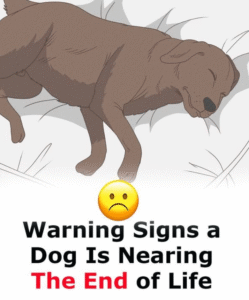Common Warning Signs a Dog Is Nearing the End of Life:
-
Loss of Interest in Food and Water:
One of the first signs is a reduced appetite. A dog that once loved treats or mealtimes may begin to ignore food altogether. Water intake may also drop, leading to dehydration. -
Extreme Fatigue and Lethargy:
Senior or terminally ill dogs may sleep most of the day and lack the energy to move. Even basic activities like walking to their food bowl or going outside may seem too hard. They may become disinterested in playing, walking, or social interaction. -
Incontinence or Trouble Moving:
A dog nearing the end may lose bladder or bowel control. Stiffness, trembling, or difficulty standing or walking is common, especially in dogs with arthritis or neurological conditions. -
Labored Breathing:
Changes in breathing—panting, shallow breaths, or long pauses—can be a serious sign. If a dog struggles to breathe or shows irregular breathing patterns, it may be close to the end. -
Withdrawal or Clinginess:
Some dogs seek solitude when they’re dying, while others may become unusually clingy, wanting to be close to their human at all times. Personality changes like these are indicators something is wrong. -
Unusual Behavior or Confusion:
Cognitive dysfunction in elderly dogs may resemble dementia. They might seem lost in familiar spaces or bark or whine for no reason. This disorientation is heartbreaking to watch. -
Chronic Pain or Discomfort:
You may notice whining, restlessness, a hunched back, or a refusal to lie down comfortably. If your dog is constantly in pain and medication doesn’t help, it could be time to have a difficult conversation with your vet.
Supporting a Dog in Their Final Days
As painful as it is, the goal during a dog’s final days is comfort. Keep them warm, offer favorite treats if they can eat, provide soft bedding, and spend time cuddling or talking gently to them. Veterinary hospice care is an option that focuses on palliative treatment, allowing dogs to pass peacefully at home.
Ultimately, recognizing the signs of approaching death allows you to make the most compassionate decisions. Whether it’s natural passing or choosing euthanasia to prevent suffering, being present and loving your dog to the very end is the greatest gift you can give.
